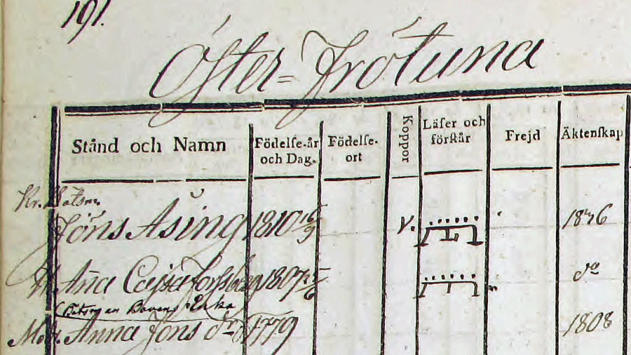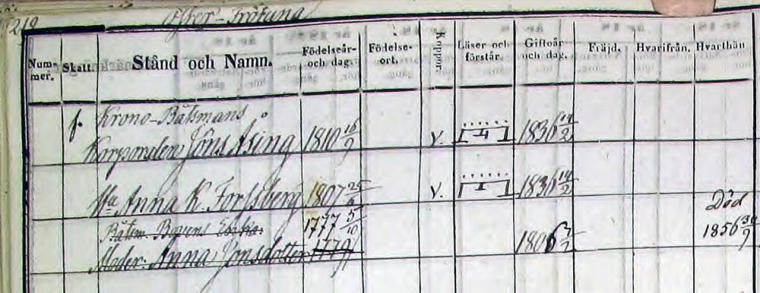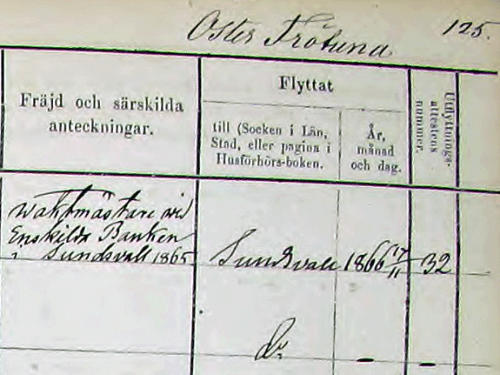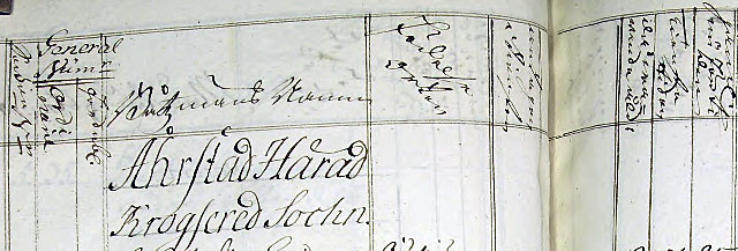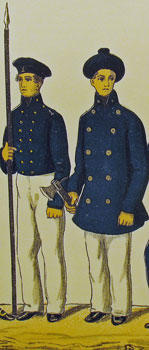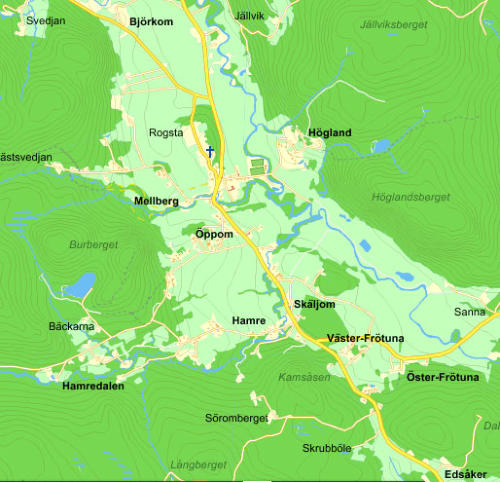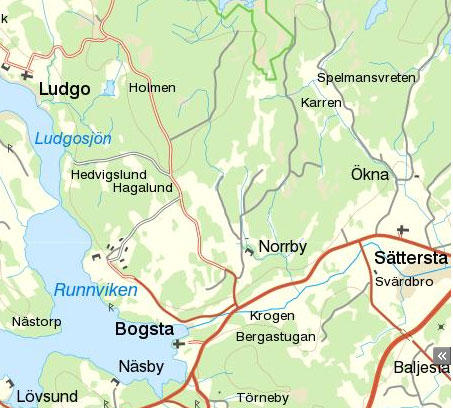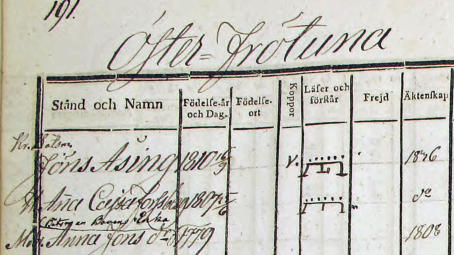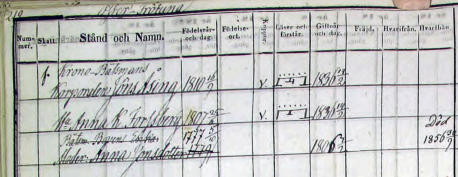

Copyright © Hans Högman 2017-07-30
How to Research Sailors in the
Navy Rolls - Sweden (Part - 2)
Tutorial 3: How to
Research Navy Sailors,
Sweden (3b)
The Jöns Jonsson Åsing Family in the Parish
Records (HFL)
Jöns Jonsson Åsing was born on September 16,
1810, in Ljustorp parish, Medlepad. He was enrolled
in the Navy on November 27, 1835, and was
discharged February 6, 1856. When Åsing was
discharged he had served as a "båtsman" in the Navy
for 21 years. Åsing died on June 2, 1880, in Öster
Frötuna, Ljustorp parish, fully 69 years old.
Ljustorp Household Examination Rolls
(Husförhörslängder) AI:5 to AI:7
Ovan, Ovan, utdrag ur husförhörslängden Ljustorp
AI:6 (1850-1860) Bild 229 / sid 219 (AID:
v121831.b229.s219, NAD: SE/HLA/1010115), Öster
Frötuna.
Här ser vi båtsmannen Jöns Åsings familj som den såg
ut 1850 - 1860, dvs för tidpunkten då han tog avsked
som båtsman. Framför hans namn står nu "förre
kronobåtsmanskorpralen".
Här sysns även Jöns Åsings vigseldatum med hans
hustru Anna Cajsa Forsberg, 1836-02-14.
Här ser vi att Jöns mor, båtsman Bovéns änka Anna
Jönsdotter, avlider 1856.
Above, extract from Ljustorp parishbook, Ljustorp
AI:5 (1841-1849) Image 203 / page 191 (AID:
v121830.b203.s191, NAD: SE/HLA/1010115), Öster
Frötuna.
The extract above lists the Åsing family as of 1841 -
1849. Jöns Åsings wife was Anna Cajsa Forsberg.
The entry also lists Jöns Åsing's mother as "båtsman
Bovéns widow Anna Jönsdotter."
Jöns Åsing's title is listed above his name, "Kr. Båtsm."
which is short for "Kronobåtsman" which simply
means sailor.
Above, extract from Ljustorp parishbook, Ljustorp
AI:7 (1861-1870) Image 133 / page 125 (AID:
v121832.b133.s125, NAD: SE/HLA/1010115), Öster
Frötuna - left-hand side.
The above extract lists Jöns Åsing as a former
båtsman (sailor). The column to the far right "Flyttad
från" (Moved from) back to Ljustorp from Sundsvall
on November 15, 1868.
As we can see below, the family moved to Sundsvall
in 1866.
Above, extract from Ljustorp parishbook, Ljustorp
AI:7 (1861-1870) Image 133 / page 125 (AID:
v121832.b133.s125, NAD: SE/HLA/1010115), Öster
Frötuna - right-hand side.
The family moved to Sundsvall city on November 17,
1866 (column "Flyttat till" - Moved to). It looks like Jöns
Åsing did well after he was discharged. He took on an
employment as a caretaker (vaktmästare) at Enskilda
Banken in Sundsvall (a bank in Sundsvall).
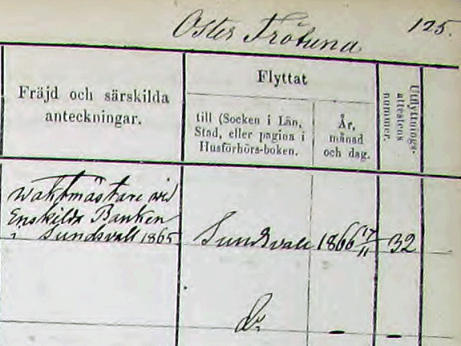
Above, extract from Ljustorp death book, Ljustorp
F:1 (1861-1895) Image 47 (AID: v121849.b47, NAD:
SE/HLA/1010115), year 1880.
Former Corporal and sailor (f. båtsmanskorpralen)
Jöns Åsing died on June 2, 1880 (first two columns).
He was then 69 years and 8 months and 16 days old.
Columns 3 and 4 tells as that he was buried on June
13, 1880.
Jöns Åsing's wife still lived when he died since he is
listed as "Gift" (Married), see the column to the far
right.
Amiralitetskollegium,
Sjömilitiekontoret - The Navy
General Muster Rolls (2)
The Amiralitetskollegium Archive (The Admiralty
Staff Archive) is another archive with rolls of interest
for the genealogy researchers. Here we find rolls such
as navy logbooks, ship muster rolls
(skeppsmönsterrullor) etc. For more information, see
chapter Other Rolls below.
The Sjömilitiekontoret (The Naval Office) is a
subseries to the Admiralty Staff Archive and contains
also navy general muster rolls. Here we have four
subseries:
1.
Regementsskrivaren för Båtsmanshållet (The
Regimental Scribe for the Navy Allotment
System). These rolls begin 1683. Here we find
båtsmän general muster rolls, principally 1700s.
2.
Regementsskrivaren för Kofferdibåtskompanierna
samt matros och Skeppsgossekåren (The
Regimental Scribe for the Merchantman Sailor
Companies and the Seamen and Ship's Boy
Corps). These rolls begin 1758.
3.
Regementsskrivarna för Volontär- och
Sjöartilleriregementena (The Regimental Scribe for
the Navy Volunteers and Sea Artillery Regiments).
These rolls begin 1692.
4.
Timmermans- och Hantverksstaterna samt
Arbetskarlar och Arrestanter (The Carpenter and
Trade Departments, Laborers and Navy
Prisoners). Very few rolls are kept.
When you are researching navy general muster rolls
you should browse both the archive "Rullor flottan
1635 - 1915" as well as the archive
"Amiralitetskollegium" to get a complete picture of
which rolls are available for a specific båtsman
company.
The general muster rolls found under
Sjömilitiekontoret (The Naval Office) mostly concerns
the 18th century.



Above, extract from "The Regimental Scribe for the
Navy Allotment System": Flottans arkiv,
Amiralitetskollegium, sjömilitiekontoret. 2.0.
Regementskrivaren för båtsmanshållet EIIIa1:6 (1757-
1759) Image 5820 (AID: v748541.b5820, NAD:
SE/KrA/0501005).
The extract above shows the first page of the South
Halland Navy Company's (Södra Halland
Båtsmanskompani) general muster roll for 1758.

Above, extract from "The Regimental Scribe for the Navy
Allotment System": Flottans arkiv, Amiralitetskollegium,
sjömilitiekontoret. 2.0. Regementskrivaren för
båtsmanshållet EIIIa1:6 (1757-1759) Image 5900 (AID:
v748541.b5900, NAD: SE/KrA/0501005).
The extract above shows a page from the South
Halland Navy Company's (Södra Halland
Båtsmanskompani) general muster roll for 1758. The
extract lists båtsman (sailor) Anders Fager born in
Köpenhamn (Copenhagen, Denmark) and was
enrolled as a båtsman in 1752. Båtsman rote 42 was
located in Krogsered parish (socken), Årstads Härad
(Hundreds), Halland län.
Båtsmansrullor - Båtsman Rolls
(Sailor Rolls)
If you are researching navy båtsmän from the 1880s
and forward you should browse the series
båtsmansrullor. They were introduced in the 1880s
(there might be some from the 1870s too). This series
is a goldmine if you have sailors from the 1880s and
thereafter. These rolls are very detailed since they
hold information regarding each sailor's duty, voyages,
grades etc. Each sailor's service data was kept in
individual books called "båtsmansrulla"; one book per
sailor. These rolls are found under respective naval
station.
For more information, see båtsmansrullor.
Other Navy Rolls
There are other navy rolls of interest for the
genealogist, such as the ship muster rolls
(skeppsmönsterrullor) and the ship logbooks
(loggböcker). To find the names of a warship's crew the
ship muster rolls are of great value. Information about
a ship's voyages are found in the logbooks.
Ship Muster Rolls (Skeppmönsterrullor)
Below is a link to the man-of-war Distigheten's ship
muster roll of 1790.
Source: Flottans arkiv: Amiralitetskollegiets med
efterföljares kontor, Arméns flotta, loggböcker, rullor
m.m.: Sjöexpeditioner, skeppsmönsterrullor 1689-
1873 A:19 (1790-1790) Image 50 / page 3 (AID:
v743172a.b50.s3, NAD: SE/KrA/0503035).
The Dristigheten was Sweden's most powerful man-of-
war at the time and carried the lowest ship number in
the Swedish Navy which means she sailed first in the
line of warships (ships of the line) in naval battles.
The Swedish Navy as well as well as the Army Fleet
(the Galley Fleet) was in June 1790 shut in by the
Russian Navy in the Bay of Vyborg, Gulf of Finland.
The Swedish navy had been pursuing the Russian
navy into the eastern part of the Gulf of Finland. The
plan was to strike a decisive blow against the
Kronstadt squadron of the Russian Navy. A few days
after the attack on the Kronstadt naval base the
Swedish Navy and the Army Fleet joined at the mouth
of the Vyborg Bay.
Then the wind changed to a southwesterly wind. The
heavy, shallow-draught warships of the time were
difficult to navigate if the wind didn't come from
astern. This made it difficult for the Swedish forces to
head toward Swedish waters in southeastern regions
of Finland.
The Swedish navy and Army Fleet had to take a
defensive position a bit further up in the Vyborg Bay
and to wait for the winds to once again change.
However, the winds didn't change and the Swedish
forces got caught in the Vyborg Bay.
The Gauntlet of Vyborg Bay:
Meanwhile, the Russian navy begun a blockade to
prevent the Swedes from leaving the bay. The
blockade was in effect on June 8th. The blockade itself
was not a threat to the two Swedish fleets. On the
contrary, the Swedish presence this close to the
Russian capital St Petersburg was a threat on Russia
and put a strain on the Empress Catharine II. The 400
Swedish ships had an armament of 3.000 guns and a
crew of 30.000 sailors and soldiers. The Navy fleet
counted 16,000 men and the Army fleet 14,000.
On July 2, 1790, the wind finally shifted. Now a
northerly wind, which made an breakout possible. The
supreme command of the fleet had a meeting. Orders
for the breakout were given during the night of July 3,
1790. The Swedish breakout from Vyborg Bay is known in
Sweden as "The Viborgska gatloppet" or in English The
Gauntlet of Vyborg Bay. First out in the line of
Swedish warships was the 64-gun ship of the line "The
Dristigheten" (The Daring).
The captain of The Dristigheten was Lieutenant Colonel
Johan af Puke (his name has nothing to do with the
English meaning of this word).
Just before the breakout, King Gustav III reminded him
of Puke's father's loyalty to the Crown and now
appealed to the son to show the same courage and
self-sacrificing spirit.
Johan af Puke answered the King "Yes, Your Majesty,
You bet your bloody life I will get through, but for the rest
of the ships, I don't know". The first Russian lock had 5
ships of the line with its broadsides towards the
approaching Swedish fleet.
It must have been quite scary for the sailors aboard
the five Russian ships to see the entire Swedish fleet
of 400 ships and 3.000 guns heading for them.
One of the Russian ships was hit by a number of
broadsides from "The Dristigheten" and was literary
torn apart. More than 700 Russians were killed. Puke
had ordered all men, not needed on deck, below deck
and therefore had no causalities. Two Russian ships
were also badly hit by the fire from the Swedish "The
Tapperheten" (The Bravery).
Remarkably, none of the Swedish ships was lost due
to Russian gun fire. All of the lost ships ran aground
due to the poor visibility caused by the heavy gun
smoke and from the ships on fires. So it was not the
Russians that directly caused the losses of Swedish
ships.
After the breakout the Swedish ships were assembled
at Vidskär (The Vidskär skerry) in the Gulf of Finland,
just south of Pitkäpaasi. Then the Navy ships set sail
and headed for the Swedish naval base at the fortress
of Sveaborg just outside Helsinki in the southwestern
part of Finland to do repairs.
The shipmaster of The Dristigheten was Lieutenant
Colonel Johan af Puke. The ship muster roll mentioned
above lists the crew of the Dristigheten including
officers, NCOs, sailors and soldiers in 1790.
See Ship muster roll for man-of-war Dristigheten
1790.
Warship Logbooks (Loggböcker)
Once you found information regarding a sailor
mustered in on a warship the next thing to do is to
view that ship's logbooks for the time period in
question to find information about that ship's voyages
and expeditions during those years.
For an example of a logbook regarding a ship in the
Galley Fleet in 1760, see Flottans arkiv:
Amiralitetskollegiets med efterföljares kontor, Arméns
flotta, loggböcker, rullor m.m.: Sjöexpeditioner,
loggböcker 1675-1852 A:1760:2 (1760-1760) Image
3410 (AID: v748546a.b3410, NAD: SE/KrA/0503034).
The Uniform
What type of military uniform did sailor Jöns Åsing in
our first example above wear when he served in the
First Norrland Second Sailor Company (Första
Norrlands 2:a-dels båtsmanskompani)? He was
enrolled on November 27, 1835 and was discharged
on February 6, 1856. Below is an image showing the
kind of uniform the navy sailor used in those days.
The sailor in our second example, Nils August Björk
in the Södermanland Second Navy Company
(Södermanlands Andra båtsmanskompani) was
enrolled in 1857. Below is an image showing the kind
of uniform he wore.
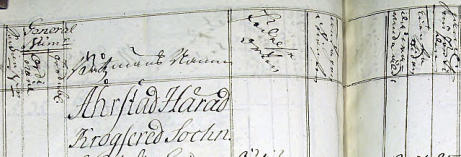



Above, Navy uniform used by the båtsmän (sailors) at
the time when Jöns Åsing served in the navy.
The left uniform is from 1832 and the right uniform is
from 1849.
Above, Navy uniform used by the båtsmän (sailors)
at the time when Nils August Björk served in the
navy.
The uniform is a navy uniform from 1856.
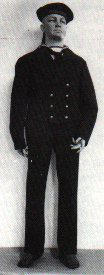
Ljustorps socken (Y) - Båtsman
172 Åsing
Where was Jöns Jonsson Åsing's sailor croft, 172
"Åsäng, Frötuna och Stafre", located? Well is was
located in Ljustorp parish, Medelpad,
Västernorrland Län.
Ljustorp is situated in a valley alongside Ljustorp
River (Ljustorpsån, a small river) about 30 km (20
miles) north of Sundsvall city. Ljustorp parish is a
part of Timrå municipality.
The area is a hilly, wooded district with many lakes.
There are hills on the west as well as the east side of
the valley (the summit of the highest hill is 411m
(1.350 ft.) above sea level).
Ljustorp consists of 32 villages in an old farming
district. The Church village (kyrkbyn) with its parish
church is centrally located in the parish.
The allotted båtsmän (sailors) in Ljustorp were
serving in the First Norrland Second Navy Company
(Första Norrlands Andradels båtsmanskompani). The
sailor croft (cottage) 172 was located in Öster
Frötuna village at the time when Jöns Jonsson Åsing
was serving in the navy.
The map to the left shows Ljustorp parish with its
villages. Öster Frötuna village is located in the
bottom-right corner of the map.
The location of the Ljustorp church is marked with a
cross.

Bogsta Parish (D) - Båtsman 65
Björk
Where was sailor croft (cottage) Knutstugan, or croft
65 "Berga och Eke" located when sailor Nils August
Björk served in the navy? Well is was located in
Bogsta parish, Södermanland Län.
Bogsta parish is since 1971 a part of Nyköping city.
The Bogsta parish church is situated by Lake
Runnviken's eastern shore. The church is from the
12th century and consist of a nave, a church tower
facing west and a vestry facing north. The chancel is
from the 15th century. The old rectory is located
across the lake and was built in 1697.
Bogsta parish is located northeast of Nyköping city,
east of Lake Runnviken. The northern part of the
parish is a hilly farming district while the southern
part is a hilly wooded district.
The sailor croft (cottage) 65 was located 1.5 km (1
mi.) north of Bogsta parish church "by the road"
when Nils August Björk was in the navy.
More about båtsman Björk.
The map to the left shows the location of Bogsta
church (marked with a cross) by Lake Runnviken.
Source: Lantmäteriets historiska kartor.
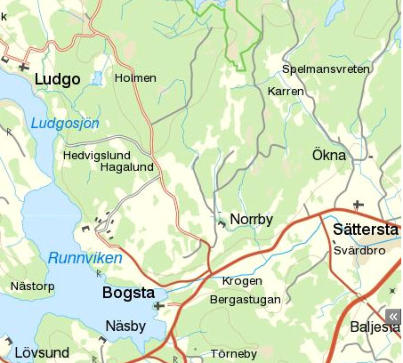
Registers
There are a number of online registers which can be
used to find information about soldiers; information
such as regiments, companies, rote, parish, date of
birth, date of death etc. This is important
information to have when you research soldiers in
the military rolls.
Centrala soldatregistret
One of the biggest online soldier register is the
Centrala soldatregistret (The Central Soldier
Register).
The register contains soldiers in the Allotment
System, i.e. soldiers and sailors (båtsmän) enrolled
between 1682 and 1901. The register has soldiers of
rank-and-file and corporals but no NCOs or officers.
There are also a few enlisted units in the register. If
you know a soldier name, you can search the
database to find out which regiment, company and
rote that soldier served. Look for a link called
There is a link “English” near the top of the page, click
it to switch to English. Click “Search Tips” for
information about how to enter data into the various
search fields.
The search-page:
http://www.ep.liu.se/databases/soldatregister/search
.en.aspx (in English).
The people behind the soldier register do not claim
that the register is complete, but new soldiers are
continuously added to the register. New data are
also added to the already registered soldiers. The
new data added might be information about the
soldiers' families.
More information about the content of the register is
found at http://www.soldatreg.se/om-basen/ . This
information is only in Swedish but you can use
services such as Google Translate to have the text
translated into English.
The soldier register is free of charge.
Båtsman Register
There are also a number of sailor registers
(båtsmansregister) available online, for example
Blekinge båtsmansregister.
In the example above about sailor Jöns Åsing in
Västernorrland I also used a register by Olof
Strömberg covering the Västernorrland sailors
(båtsmän); http://www.gstromberg.nu/ .
Note that all these registers are secondary sources
and must be treated as such. Use them to get a fast
entry to the primary sources, i.e. the general muster
rolls and others.
Always verify information found in a secondary source
with the corresponding information in the primary
source.







